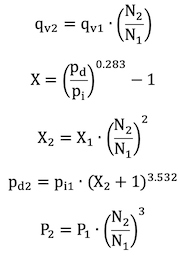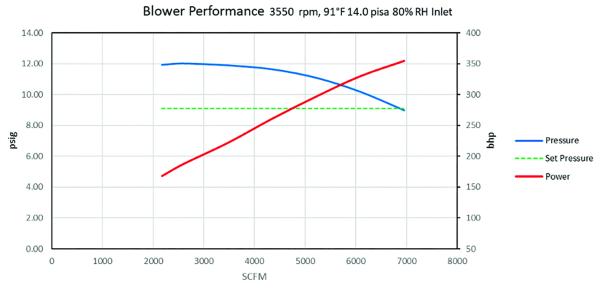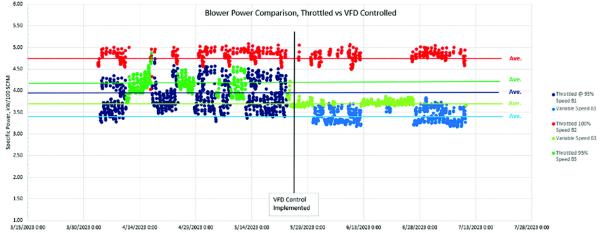By Tom Jenkins, JenTech and Lee Pinkerton, Metropolitan Council Environmental Services
02/23/2024
Many designers and operators believe that multistage centrifugal blowers are not suitable for variable speed control. They also feel that multistage centrifugal blowers are an inefficient option for wastewater aeration.
The Eagles Point WWTP has demonstrated that these opinions are based on faulty assumptions. Implementing VFD control of their aeration blowers allowed the plant to improve energy efficiency. The reduction in energy expense paid for the system upgrade in less than two years.
Throttling
It is common practice to control multistage centrifugal blower air flow using an inlet throttling valve. Valves are inexpensive, the control is intuitive for operators, and throttling will reduce both discharge air flow and power. Prior to the commercialization of cost-effective Variable Frequency Drives (VFDs) inlet throttling was essentially the only feasible method for controlling vertically split multistage centrifugals. Horizontally split multistage blowers could use inlet guide vanes, but they were only available for very large blowers.
Throttling creates a pressure drop across a valve. The pressure drop varies with the valve opening and flow rate. Throttling does reduce the discharge pressure, the flow rate, and the blower power. However, at a given inlet volumetric flow rate the pressure ratio across the blower is constant. Inlet throttling simply shifts a portion of the pressure ratio to the inlet side of the blower while reducing the air density. This represents a parasitic loss of energy.
Variable Speed Control
All centrifugal blowers can be controlled by changing their speed. The affinity laws (sometimes referred to as the “fan laws”) govern the behavior of blower performance when speed is changed:

Where:
qv = Volumetric flow rate, cfm
N = Speed, rpm
X = Adiabatic factor, dimensionless
p = Pressure, psia
P = Power, kW
Unlike throttling, which maintains the pressure ratio at a given flow, reducing blower speed reduces both flow and pressure directly. Throttling dissipates pressure through the valve. Reducing speed reduces the pressure created. That’s why variable speed control is more efficient than throttling.
Although variable speed control can be applied to any centrifugal blower, some characteristics provide wider operating range, improved stability, and increased savings. In general, a high rise to surge and steadily rising pressure vs. flow curve are preferrable to flat curves.
VFD control of multistage centrifugal aeration blowers has been used for over thirty years. Despite this, many designers are unaware that the technique is cost effective and reliable.
Eagles Point WWTP
The Eagles Point WWTP is in Cottage Grove, MN. It is one of several plants in Minnesota’s seven county metro area operated by the Metropolitan Council. The Eagles Point WWTP average daily flow (ADF) is 5.2 mgd. Three identical multistage centrifugal blowers, installed in 2001, provide air for the secondary aeration basins. Two of the blowers, B1 and B3, have 400 hp motors and the standby blower B2 has a 350 hp motor. Nominal full load speed for all motors is 3550 rpm. The blowers are rated at 8,000 icfm and 10.63 psig discharge pressure. Specified inlet conditions were 13.99 psia at inlet temperatures ranging from -16°F to 91°F. See Figure 1.

The blower system uses PLCs to maintain a constant discharge header pressure of 9.10 psig. B1 and B3 are alternated as the lead blower. B2, the standby, is operated when one blower cannot meet the total system air demand. The inlet valves are modulated by the blower PLC using a 4-20 mA position signal.
In 2017 the motor starters for B1 and B3 were replaced with VFDs. At that time the intent was to have the VFDs provide soft start for the motors. The system designer advised the plant staff that the multistage centrifugal blowers were not suitable for variable speed control of capacity. All three blowers continued to be controlled by inlet throttling.
The blower instrumentation package is well designed and complete. Each VFD and the B2 motor starter provide a motor power signal to the PLC system. Each blower is also equipped with a thermal mass air flow meter in its discharge piping. The blower’s inlet and discharge are equipped with temperature and pressure transmitters. Performance for all three blowers is logged at ten second intervals by the plant SCADA (Supervisory Control and Data Acquisition) system.
Evaluation
It can be difficult to evaluate the blower power reduction obtained from energy conservation measures (ECMs). Percent efficiency comparisons are difficult. Aeration blowers operate across a wide range of flow and power as hydraulic and organic load to the aeration system changes. The blower efficiency is decreased as the flow rate moves away from the Best Efficiency Point (BEP). Inlet temperature and discharge pressure vary, contributing to power fluctuations.
A convenient metric is specific power, sometimes called specific energy. Typically expressed as kW/100 cfm, it is easily understood and can be used to compare different equipment under the same operating conditions. This parameter was chosen for performance comparisons.

Where:
e = Specific power, kW/100 scfm
qv = Measured flow rate, scfm (68°F, 14.7 psia, 36% RH)
P = Measured blower power, kW
Total energy consumption and energy cost were used to evaluate the cost effectiveness of VFD control.
Initial Steps
The plant was aware that other facilities had implemented variable speed control for similar aeration blowers. Because of the designer’s concerns, however, they opted to take a careful, step by step approach to utilizing the VFD’s capabilities.
The staff’s first step was based on the recognition that the design discharge pressure was significantly higher than the actual operating pressure. This increased the pressure loss across the inlet throttling valves. To reduce the amount of throttling, the speed of B1 and B3 was reduced to a constant 95% of nominal (3370 rpm).
Stepping down the blower speed had a very favorable effect on specific power. See Table 1.
|
Table 1: Average Specific Power, kW/100 scfm |
|
| B1, 95% Speed, Inlet Throttled | 3.93 |
| B2, 100% Speed, Inlet Throttled | 4.76 |
| B3, 95% Speed, Inlet Throttled | 4.17 |
When controlled by throttling at lower constant speed, both blowers showed significant improvement compared to B2, which continued to operate at 100% speed.
Variable Speed Control
The success of operating at a reduced constant speed led the plant staff to consider full variable speed control.
The next step was to use the affinity laws and blower thermodynamics to calculate the reduced speed performance for the blowers. The staff then tested the blowers by manually adjusting the speed and comparing the performance with the calculated parameters. The result was close agreement between theoretical and actual performance. The difference between measured and calculated results was less than 3%.
Encouraged by the calculations and the test results the plant made the minor modifications to the PLC program necessary to convert control from inlet throttling valve to VFDs and variable speed. The changes were implemented in May 2023.
The improvement was immediate and obvious. See Figure 2 and Table 2. The power savings were, as anticipated, substantial.

|
Table 2: Average Specific Power, kW/100 scfm |
|
| B1, Variable Speed | 3.40 |
| B2, 100% Speed, Inlet Throttled | 4.76 |
| B3, Variable Speed | 3.71 |
Variable speed control provided an average specific power for B1 and B3 of 3.55 kW/100 scfm. The improvement of 1.2 kW/100scfm represents a reduction of 25% compared to full speed throttling control of B2.
Concerns about the stability of the blowers under VFD control proved unfounded. The discharge pressure was maintained at the set 9.10 psig with a standard deviation of ±0.07 psig. The blower speed was steady; no hunting occurred.
The savings for full VFD control compared to throttling B1 and B3 at a constant reduced speed were 0.5 kW/100 scfm, a 12% improvement.
The plant calculated that using VFD control reduced the power cost by 17%. This resulted in annual savings of $28,100 based on the current power cost. The initial payback estimate for VFD implementation was 2.5 years. This did not include the electric utility incentive, which reduced the payback to 1.5 years.
Conclusions
Although variable speed control of centrifugal aeration blowers is well established technology, many operators and designers are still unfamiliar with the application. The result is lost opportunities for cost effective energy conservation projects.
It is still common practice to use inlet throttling to control multistage centrifugal blowers. This is an inefficient technique which creates pressure drops across the valve and results in power loss. Using variable speed control is inherently more efficient, since flow and pressure are directly controlled and optimized.
The Eagles Point experience clearly demonstrates the advantages of variable speed control. It is an example of a retrofit application of VFDs to an existing aeration blower system. The Eagles Point experience proves that the more common approach of inlet throttling doesn’t optimize energy consumption. Variable speed control is the key to high efficiency with multistage centrifugal blowers.
About the Authors
Tom Jenkins has over forty years’ experience in blowers and blower applications. As an inventor and entrepreneur, he has pioneered many innovations in aeration and blower control. He is an Adjunct Professor at the University of Wisconsin, Madison and a WEF Fellow. Tom is the current Chair of the ASME PTC 13 Committee. For more information, visit www.jentechinc.com.
Lee Pinkerton is Senior Engineer for the Metropolitan Council Environmental Services in the Research and Development group. He has been working for the Metropolitan Council for 6 years and works on a variety of special projects from aeration, blowers, and process modeling to wastewater-based epidemiology. Lee received a B.S. in Chemical Engineering from the University of Wisconsin-Madison.
For similar articles on Aeration Blowers please visit https://www.blowervacuumbestpractices.com/technology/aeration-blowers.
Visit our Webinar Archives to listen to expert presentations on Aeration Blower Technology at https://www.blowervacuumbestpractices.com/magazine/webinars.
March 2024



